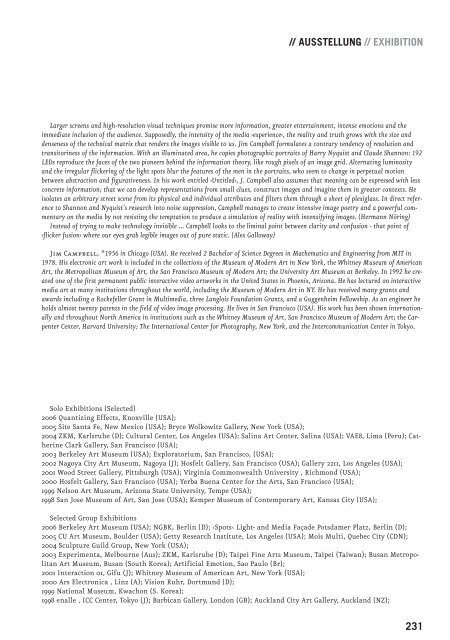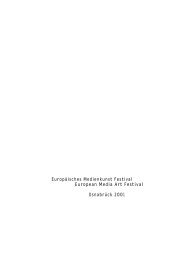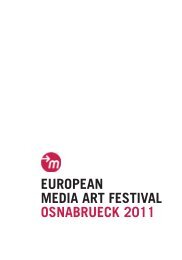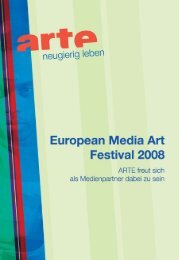You also want an ePaper? Increase the reach of your titles
YUMPU automatically turns print PDFs into web optimized ePapers that Google loves.
AUSSTELLUNG // EXHIBITION<br />
Larger screens and high-resolution visual techniques promise more information, greater entertainment, intense emotions and the<br />
immediate inclusion of the audience. Supposedly, the intensity of the media ›experience‹, the reality and truth grows with the size and<br />
denseness of the technical matrix that renders the images visible to us. Jim Campbell formulates a contrary tendency of resolution and<br />
transitoriness of the information. With an illuminated area, he copies photographic portraits of Harry Nyquist and Claude Shannon: 192<br />
LEDs reproduce the faces of the two pioneers behind the information theory, like rough pixels of an image grid. Alternating luminosity<br />
and the irregular flickering of the light spots blur the features of the men in the portraits, who seem to change in perpetual motion<br />
between abstraction and figurativeness. In his work entitled ›<strong>Untitled</strong>‹, J. Campbell also assumes that meaning can be expressed with less<br />
concrete information; that we can develop representations from small clues, construct images and imagine them in greater contexts. He<br />
isolates an arbitrary street scene from its physical and individual attributes and filters them through a sheet of plexiglass. In direct reference<br />
to Shannon and Nyquist's research into noise suppression, Campbell manages to create intensive image poetry and a powerful commentary<br />
on the media by not resisting the temptation to produce a simulation of reality with intensifying images. (Hermann Nöring)<br />
Instead of trying to make technology invisible ... Campbell looks to the liminal point between clarity and confusion - that point of<br />
›flicker fusion‹ where our eyes grab legible images out of pure static. (Alex Galloway)<br />
Jim Campbell, *1956 in Chicago (USA). He received 2 Bachelor of Science Degrees in Mathematics and Engineering from MIT in<br />
1978. His electronic art work is included in the collections of the Museum of Modern Art in New York, the Whitney Museum of American<br />
Art, the Metropolitan Museum of Art, the San Francisco Museum of Modern Art; the University Art Museum at Berkeley. In 1992 he created<br />
one of the first permanent public interactive video artworks in the United States in Phoenix, Arizona. He has lectured on interactive<br />
media art at many institutions throughout the world, including the Museum of Modern Art in NY. He has received many grants and<br />
awards including a Rockefeller Grant in Multimedia, three Langlois Foundation Grants, and a Guggenheim Fellowship. As an engineer he<br />
holds almost twenty patents in the field of video image processing. He lives in San Francisco (USA). His work has been shown internationally<br />
and throughout North America in institutions such as the Whitney Museum of Art, San Francisco Museum of Modern Art; the Carpenter<br />
Center, Harvard University; The International Center for Photography, New York, and the Intercommunication Center in Tokyo.<br />
Solo Exhibitions (Selected)<br />
2006 Quantizing Effects, Knoxville (USA);<br />
2005 Site Santa Fe, New Mexico (USA); Bryce Wolkowitz Gallery, New York (USA);<br />
2004 ZKM, Karlsruhe (D); Cultural Center, Los Angeles (USA); Salina Art Center, Salina (USA); VAE8, Lima (Peru); Catherine<br />
Clark Gallery, San Francisco (USA);<br />
2003 Berkeley Art Museum (USA); Exploratorium, San Francisco, (USA);<br />
2002 Nagoya City Art Museum, Nagoya (J); Hosfelt Gallery, San Francisco (USA); Gallery 2211, Los Angeles (USA);<br />
2001 Wood Street Gallery, Pittsburgh (USA); Virginia Commonwealth University , Richmond (USA);<br />
2000 Hosfelt Gallery, San Francisco (USA); Yerba Buena Center for the Arts, San Francisco (USA);<br />
1999 Nelson Art Museum, Arizona State University, Tempe (USA);<br />
1998 San Jose Museum of Art, San Jose (USA); Kemper Museum of Contemporary Art, Kansas City (USA);<br />
Selected Group Exhibitions<br />
2006 Berkeley Art Museum (USA); NGBK, Berlin (D); ›Spots‹ Light- and Media Façade Potsdamer Platz, Berlin (D);<br />
2005 CU Art Museum, Boulder (USA); Getty Research Institute, Los Angeles (USA); Mois Multi, Quebec City (CDN);<br />
2004 Sculpture Guild Group, New York (USA);<br />
2003 Experimenta, Melbourne (Aus); ZKM, Karlsruhe (D); Taipei Fine Arts Museum, Taipei (Taiwan); Busan Metropolitan<br />
Art Museum, Busan (South Korea); Artificial Emotion, Sao Paulo (Br);<br />
2001 Interaction 01, Gifu (J); Whitney Museum of American Art, New York (USA);<br />
2000 Ars Electronica , Linz (A); Vision Ruhr, Dortmund (D);<br />
1999 National Museum, Kwachon (S. Korea);<br />
1998 enalle , ICC Center, Tokyo (J); Barbican Gallery, London (GB); Auckland City Art Gallery, Auckland (NZ);<br />
231












